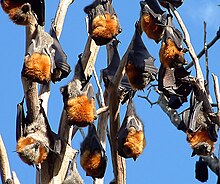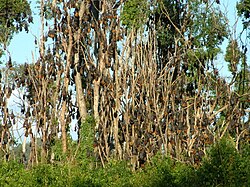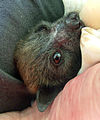- I wasn't able to retrieve the image bing has today on their homepage for some reason so I realized I should share the flying fox which is the largest bat in the world that lives in Australia.
- The Image is of a single bat hanging upside down Vampire style.
- Begin quote from:
Grey-headed flying fox - Wikipedia
-
Grey-headed flying fox
From Wikipedia, the free encyclopediaThe grey-headed flying fox (Pteropus poliocephalus) is a megabat native to Australia.[2] The species shares mainland Australia with three other members of the genus Pteropus: the little red flying fox (P. scapulatus), the spectacled flying fox (P. conspicillatus), and the black flying fox (P. alecto).Grey-headed flying fox 
Scientific classification Kingdom: Animalia Phylum: Chordata Class: Mammalia Order: Chiroptera Family: Pteropodidae Genus: Pteropus Species: P. poliocephalus Binomial name Pteropus poliocephalus
(Temminck, 1825)
Native distribution of P. poliocephalus
The grey-headed flying fox is endemic to the south-eastern forested areas of Australia, principally east of the Great Dividing Range. Its range extends approximately from Bundaberg in Queensland to Geelong in Victoria, with outlying colonies in Ingham and Finch Hatton in the north, and in Adelaide in the south. In the southern parts of its range it occupies more extreme latitudes than any other Pteropus species.
Contents
Physical characteristics
The grey-headed flying fox is the largest bat in Australia. This flying fox has a dark-grey body with a light-grey head and a reddish-brown neck collar of fur. It is unique among bats of the genus Pteropus in that fur on the legs extends all the way to the ankle. Adults have an average wingspan up to 1 m (3.3 ft) and can weigh up to 1 kg (2.2 lb). The head and body length is between 230 and 289 mm (9.1 and 11.4 in), with an average of 253 mm (10.0 in). The forearm length is between 138 and 180 mm (5.4 and 7.1 in), with an average of 161 mm. Weight generally varies between 600 and 1,000 g (1.3 and 2.2 lb), with an average of 677 g (1.493 lb). It is tailless, with claws on its first and second digits. Since it does not echolocate, it lacks tragus or leaf ornamentation found in most species of Microchiroptera. It relies on sight to locate its food (nectar, pollen and native fruits) and thus has relatively large eyes for a bat.Grey-headed flying-fox shows wingspan
The grey-headed flying fox is long-lived for a mammal of its size. Individuals reportedly survived in captivity for up to 23 years, and a maximum age of up to 15 years seems possible in the wild.[citation needed]
Ecology
Habitat and movements
Grey-headed flying foxes live in a variety of habitats, including rainforests, woodlands, and swamps.[3] During the day, individuals reside in large roosts (colonies or 'camps') consisting of hundreds to tens of thousands of individuals. Colonies are formed in seemingly arbitrary locations. Roost vegetation includes rainforest patches, stands of melaleuca, mangroves, and riparian vegetation, but roosts also occupy highly modified vegetation in urban areas. A prominent example existed at the Royal Botanic Gardens in Sydney. However, the Garden instituted a successful policy to remove them from the garden grounds. The camp is now dispersed across Queensland.[4][5]
Movements of grey-headed flying foxes are influenced by the availability of food. Their population is very fluid, as they move in response to the irregular blossoming of certain plant species. The grey-headed flying fox is a partial migrant that uses winds to facilitate long-distance movement.[6] It does not migrate in a specific direction, but rather in the direction that will be the most beneficial at the time.[6]
Diet and foraging
Around dusk, grey-headed flying foxes leave the roost and travel up to 50 km a night to feed on pollen, nectar and fruit.[6] The species consumes fruit flowers and pollens of around 187 plant species.[7] Theses include Eucalyptus, particularly Eucalyptus gummifera, Eucalyptus muellerana, Eucalyptus globoidea and Eucalyptus botryoides,[3][8] and fruits from a wide range of rainforest trees, including members of the Ficus genus.[3][8] These bats are considered sequential specialists, since they feed on a variety of foods.[8] Grey-headed flying foxes, along with the three other Australian flying fox species, fulfill a very important ecological role by dispersing the pollen and seeds of a wide range of native Australian plants. The grey-headed flying fox is the only mammalian nectarivore and frugivore to occupy substantial areas of subtropical rainforests, so is of key importance to those forests.Grey-headed flying fox colony
Most vegetation communities on which this species forages produce nectar and pollen seasonally and are abundant unpredictably, so the flying fox's migration traits cope with this. The time when flying foxes leave their roosts to feed depends on foraging light and predation risk.[9] Flying foxes have more time and light when foraging if they leave their roosts early in the day.[9] The entire colony may leave later if a predatory bird is present, while lactating females leave earlier.[9] With males, the bachelors leave earlier than harem-holding males, which guard their wait until all their females have left.[9] The flying foxes that leave the roost earlier are more vulnerable to predation, and some other flying foxes will wait for others to leave, a phenomenon labelled the "after you" effect.[9]
Social organisation
Groupings and territories
Grey-headed flying foxes form two different roosting camps, summer camps and winter camps.[10] Summer camps are used from September to April or June. In these camps, they establish territories, mate, and reproduce.[10] Winter camps are used from April to September. The sexes are separated in winter camps and most behaviour is characterised by mutual grooming.[10] Summer camps are considered "main camps", while winter camps are referred to as "transit camps".[10]
In their summer camps, starting in January, male grey-headed flying foxes set up mating territories. Mating territories are generally 3.5 body lengths along branches.[11] These flying foxes' neck glands enlarge in males in the mating season, and are used to mark the territories.[11] The males fight to maintain their territories, and this is associated with a steep drop in the males' body condition during this time.[12][13] Around the beginning of the mating season, adult females move from the periphery towards the central male territories where they become part of short-term ‘harems’ that consist of a male and an unstable group of up to five females.[11] Centrally located males are polygamous, while males on the periphery are monogamous or single.[10][11] The mating system of the grey-headed flying fox is best described as a lek because males do not provide any essential resources to females and are chosen on the basis of their physical location within the roost, which correlates with male quality.[11]
Although recorded in small numbers sporadically throughout twentieth century it was not until the 1980s that Grey-headed flying foxes routinely visited Melbourne.[14] Since the 1990s their permanent colony in Melbourne has been postulated as possibly due to habitat loss in their northern range, greater supply of reliable food by native eucalypt plantings and backyard fruit trees, climate change, and increase urbanisation leading to warmer temperatures.[14]
Mating
Matings are generally observed between March and May, but the most likely time of conception is April.[15] Most mating takes place in the territories and during the day. Females have control over the copulation process, and males may have to keep mating with the same females.[16] Females usually give birth to one young each year.[17] Gestation lasts around 27 weeks,[18] and pregnant females give birth between late September and November. Late births into January are sometimes observed. The altricial newborns rely on their mothers for warmth.[19] For their first three weeks, young cling to their mothers when they go foraging. After this, the young remain in the roosts. By January, young are capable of sustained flight, and by February, March or April are fully weaned.
Predation
Flying foxes are preyed on by eagles, goannas, and snakes,[10] as well as crocodiles.
Conservation
The grey-headed flying fox is now a prominent federal conservation problem in Australia. Early in the last century, the species was considered abundant, with numbers estimated in the many millions. In recent years, though, direct evidence has been accumulating that the species is in serious decline. Current estimates for the species are about 610,000, and the national population may have declined by over 30% between 1989 and 1999 alone.[20]A grey-headed flying fox electrocuted between electricity transmission lines in suburban Sydney
Threats
Grey-headed flying foxes are exposed to several threats, including loss of foraging and roosting habitat,[21] competition with the black flying fox, and mass die-offs caused by extreme temperature events.[11] When present in urban environments, grey-headed flying foxes are sometimes perceived as a nuisance. Cultivated orchard fruits are also taken, but apparently only at times when other food items are scarce. Because their roosting and foraging habits bring the species into conflict with humans, they suffer from direct killing of animals in orchards and harassment and destruction of roosts. Negative public perception of the species has intensified with the discovery of three recently emerged zoonotic viruses that are potentially fatal to humans: Hendra virus, Australian bat lyssavirus and Menangle virus.[22] However, only Australian bat lyssavirus is known from two isolated cases to be directly transmissible from bats to humans.
Recent research has shown, since 1994, more than 24,500 grey-headed flying foxes have died from extreme heat events alone.[23] To answer some of the growing threats, roost sites have been legally protected since 1986 in New South Wales and since 1994 in Queensland. In 1999, the species was classified as “Vulnerable to extinction” in The Action Plan for Australian Bats,[24] and has since been protected across its range under Australian federal law. As of 2008 the species is listed as “Vulnerable” on the IUCN Red List of Threatened Species.[1]A male grey-headed flying fox, suffering from heat stress during a heatwave in New South Wales
Wildlife rescue
This section does not cite any sources. (March 2015) (Learn how and when to remove this template message) Bat caregivers are not only specially trained in techniques to rescue and rehabilitate bats, but they are also vaccinated against rabies. Although the chance of contracting the rabies-like Australian bat lyssavirus is extremely small, bat caregivers are inoculated for their own protection.Crib full of abandoned babies rescued by Wildcare Australia in care at The Bat Hospital
Flying foxes often come to the attention of Australian wildlife care and rescue organisations, such as Wildcare Australia, ONARR, Wildlife Carers Darling Downs, Bat Care, Bat Rescue, Tweed Valley Wildlife Carers, WIRES, and Wildlife Victoria when reported as injured, sick, orphaned, or abandoned. A very high proportion of adult flying fox injuries are caused by entanglement in barbed wire fences or backyard fruit tree netting, both of which can result in very serious injuries and a slow, agonising death for the animal if not rescued quickly. More recently wildlife advocacy groups such the Victorian Advocates for Animals has used the commercial development of a range of wildlife safe fruit tree netting products to push for regulations to make it illegal to install wildlife unsafe nets on backyard fruit trees. These new products have as their chief characteristic small apertures / holes of 5mm x 5mm or less. Flying foxes are able to climb across the netting without being entangled. It is hoped the uptake of wildlife safe netting products will see a marked decline in flying fox entanglements across time and subsequent reduction in public risk and the burden on wildlife rescue and rehabilitation volunteers.
Baby flying foxes usually come into care after having been separated from their mothers. Babies are often orphaned during four to six weeks of age, when they inadvertently fall off their mothers during flight. When they are older, orphans usually come into care because of maternal death from power line electrocution or barbed wire entanglement. A rare, but apparent natural, occurrence of mass abandonment can lead to the rescue of hundreds of babies at one time. The latter most recently occurred in November 2008 at the Canungra bat camp in South East Queensland, when Wildcare Australia, working closely with the EPA and regional bat care groups, rescued and rehabilitated over 300 baby grey-headed flying foxes. Most babies are in a dehydrated and distressed state by the time they are rescued, and some are infested with maggots if found sick or injured. A young flying fox must be fed every four hours, and then as it develops it is introduced to blossoms and fruit. When the young flying fox is fully weaned around 10 to 12 weeks of age, it goes into a crèche for rehabilitation and eventual release.
Gallery
-
Grey-headed flying foxes in Royal Botanic Gardens, Sydney
-
Grey-headed flying fox with baby (the smaller bat in the back is a little red flying fox
References
- "The Action Plan for Australian Bats - Recovery outlines: Grey-headed Flying-fox". Environment.gov.au. Retrieved 2014-02-22.
Further reading
- Eby, P. (2000). "The results of four synchronous assessments of relative distribution and abundance of Grey-headed Flying-fox Pteropus poliocephalus". In Hall, L. Proceedings of a Workshop to Assess the Status of the Grey-headed Flying-Fox. Canberra: Australasian Bat Society.
- Menkhorst, P.; Knight, F. (2001). A field guide to the mammals of Australia. South Melbourne: Oxford University Press. ISBN 0-19-550870-X.
- Nelson, J. E. W. (1965). "Behavior of Australian Pteropodidae (Megachiroptera)". Animal Behaviour. 13 (4): 544–557. doi:10.1016/0003-3472(65)90118-1. PMID 5882814.
- Tidemann, C. R. (1999). "Biology and management of the grey-headed flying-fox, Pteropus poliocephalus". Acta Chiropterologica. 1: 151–164.
- Welbergen, J.; Klose, S.; Markus, N.; Eby, P. (2008). "Climate change and the effects of temperature extremes on Australian flying-foxes". Proceedings. Biological sciences / the Royal Society. 275 (1633): 419–425. doi:10.1098/rspb.2007.1385. PMC 2596826
 . PMID 18048286.
. PMID 18048286. - Klose, S. M.; Welbergen, J. A.; Kalko, E. K. V. (2009). "Testosterone is associated with harem maintenance ability in free-ranging grey-headed flying-foxes, Pteropus poliocephalus". Biology Letters. 5: 758. doi:10.1098/rsbl.2009.0563.
- Klose, S. M.; Welbergen, J. A.; Goldizen, A. W.; Kalko, E. K. V. (2008). "Spatio-temporal vigilance architecture of an Australian flying-fox colony". Behavioral Ecology and Sociobiology. 63 (3): 371. doi:10.1007/s00265-008-0671-8.
External links
| Wikimedia Commons has media related to Pteropus poliocephalus. |
| Wikispecies has information related to: Pteropus poliocephalus |















No comments:
Post a Comment